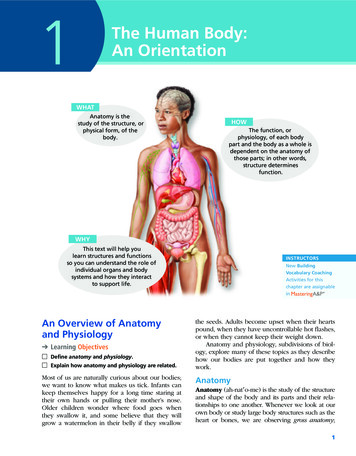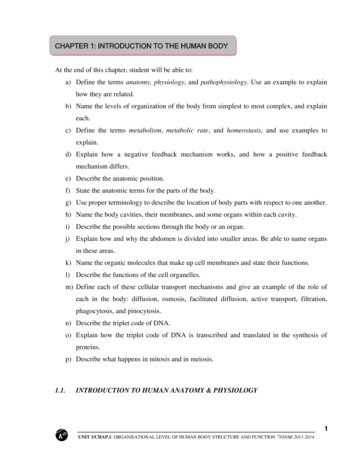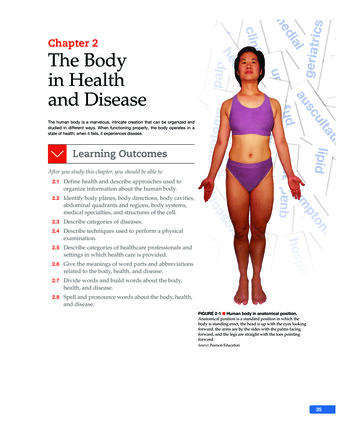
Transcription
Organization of the HumanBodySay Thanks to the AuthorsClick http://www.ck12.org/saythanks(No sign in required)
To access a customizable version of this book, as well as otherinteractive content, visit www.ck12.orgCK-12 Foundation is a non-profit organization with a mission toreduce the cost of textbook materials for the K-12 market both inthe U.S. and worldwide. Using an open-source, collaborative, andweb-based compilation model, CK-12 pioneers and promotes thecreation and distribution of high-quality, adaptive online textbooksthat can be mixed, modified and printed (i.e., the FlexBook textbooks).Copyright 2015 CK-12 Foundation, www.ck12.orgThe names “CK-12” and “CK12” and associated logos and theterms “FlexBook ” and “FlexBook Platform ” (collectively“CK-12 Marks”) are trademarks and service marks of CK-12Foundation and are protected by federal, state, and internationallaws.Any form of reproduction of this book in any format or medium,in whole or in sections must include the referral attribution linkhttp://www.ck12.org/saythanks (placed in a visible location) inaddition to the following terms.Except as otherwise noted, all CK-12 Content (including CK-12Curriculum Material) is made available to Users in accordancewith the Creative Commons Attribution-Non-Commercial 3.0Unported (CC BY-NC 3.0) License (http://creativecommons.org/licenses/by-nc/3.0/), as amended and updated by Creative Commons from time to time (the “CC License”), which is incorporatedherein by this reference.Complete terms can be found at http://www.ck12.org/about/terms-of-use.Printed: October 29, 2015
www.ck12.orgC HAPTERChapter 1. Organization of the Human Body1Organization of the HumanBodyLesson Objectives Outline the levels of organization of the human body. Explain how organ systems maintain homeostasis of the body.Vocabulary connective tissueepithelial tissuemuscle tissuenervous tissueIntroductionMany people have compared the human body to a machine. Think about some common machines, such as drillsand washing machines. Each machine consists of many parts, and each part does a specific job, yet all the partswork together to perform an overall function. The human body is like a machine in all these ways. In fact, it maybe the most fantastic machine on Earth, as you will discover when you learn more about it in this and the remainingchapters of this resource.As a preview of the human machine, the Emmy award-winning video at this link is highly recommended: http://www.youtube.com/watch?v chqwSh4ii84 .MEDIAClick image to the left or use the URL below.URL: evels of OrganizationThe human machine is organized at different levels, starting with the cell and ending with the entire organism (seeFigure 1.1). At each higher level of organization, there is a greater degree of complexity.1
www.ck12.orgFIGURE 1.1Just like this bird, the human organism has several levels of organization.CellsThe most basic parts of the human machine are cells—an amazing 100 trillion of them by the time the average personreaches adulthood! Cells are the basic units of structure and function in the human body, as they are in all livingthings. Each cell carries out basic life processes that allow the body to survive. Many human cells are specializedin form and function, as shown in Figure 1.2. Each type of cell in the figure plays a specific role. For example,nerve cells have long projections that help them carry electrical messages to other cells. Muscle cells have manymitochondria that provide the energy they need to move the body.You can watch a video about some of the specialized cells of the human body and how they function at this link:http://www.youtube.com/watch?v I8uXewS9dJU .FIGURE 1.2Different types of cells in the human bodyare specialized for specific jobs. Do youknow the functions of any of the cell typesshown here?2
www.ck12.orgChapter 1. Organization of the Human BodyTissuesAfter the cell, the tissue is the next level of organization in the human body. A tissue is a group of connected cellsthat have a similar function. There are four basic types of human tissues: epithelial, muscle, nervous, and connectivetissues. These four tissue types, which are shown in Figure 1.3, make up all the organs of the human body.FIGURE 1.3The human body consists of these fourtissue types. Connective tissue is made up of cells that form the body’s structure. Examples include bone and cartilage. Epithelial tissue is made up of cells that line inner and outer body surfaces, such as the skin and the liningof the digestive tract. Epithelial tissue protects the body and its internal organs, secretes substances such ashormones, and absorbs substances such as nutrients. Muscle tissue is made up of cells that have the unique ability to contract, or become shorter. Muscles attachedto bones enable the body to move. Nervous tissue is made up of neurons, or nerve cells, that carry electrical messages. Nervous tissue makes upthe brain and the nerves that connect the brain to all parts of the body.Organs and Organ SystemsAfter tissues, organs are the next level of organization of the human body. An organ is a structure that consists of twoor more types of tissues that work together to do the same job. Examples of human organs include the brain, heart,lungs, skin, and kidneys. Human organs are organized into organ systems, many of which are shown in Figure 1.4.An organ system is a group of organs that work together to carry out a complex overall function. Each organ of thesystem does part of the larger job.You can watch overviews of the human organ systems and their functions at the links below. http://www.youtube.com/watch?v po8D290YF9o http://www.youtube.com/watch?v SSqwRkDLyH4 http://www.youtube.com/watch?v KidJ-2H0nyY3
www.ck12.orgFIGURE 1.4Many of the organ systems that make up the human body are represented here. What is the overall function ofeach organ system?4
www.ck12.orgChapter 1. Organization of the Human BodyA Well-Oiled MachineAll of the organs and organ systems of the human body work together like a well-oiled machine. This is becausethey are closely regulated by the nervous and endocrine systems. The nervous system controls virtually all bodyactivities, and the endocrine system secretes hormones that regulate these activities. Functioning together, the organsystems supply body cells with all the substances they need and eliminate their wastes. They also keep temperature,pH, and other conditions at just the right levels to support life processes.Maintaining HomeostasisThe process in which organ systems work to maintain a stable internal environment is called homeostasis. Keepinga stable internal environment requires constant adjustments. Here are just three of the many ways that human organsystems help the body maintain homeostasis: Respiratory system: A high concentration of carbon dioxide in the blood triggers faster breathing. The lungsexhale more frequently, which removes carbon dioxide from the body more quickly. Excretory system: A low level of water in the blood triggers retention of water by the kidneys. The kidneysproduce more concentrated urine, so less water is lost from the body. Endocrine system: A high concentration of sugar in the blood triggers secretion of insulin by an endocrinegland called the pancreas. Insulin is a hormone that helps cells absorb sugar from the blood.Failure of HomeostasisMany homeostatic mechanisms such as these work continuously to maintain stable conditions in the human body.Sometimes, however, the mechanisms fail. When they do, cells may not get everything they need, or toxic wastesmay accumulate in the body. If homeostasis is not restored, the imbalance may lead to disease or even death.Lesson Summary The human body is organized at different levels, starting with the cell. Cells are organized into tissues, andtissues form organs. Organs are organized into organ systems such as the skeletal and muscular systems. All of the organ systems of the body work together to maintain homeostasis of the organism. If homeostasisfails, death or disease may result.Lesson Review QuestionsRecall1. What are the levels of organization of the human body?2. Which type of tissue covers the surface of the body?3. What are the functions of the skeletal system?4. Which organ system supports the body and allows it to move?5. What is homeostasis?5
www.ck12.org6. Describe how one of the human organ systems helps maintain homeostasis.Apply Concepts7. A house has several systems, such as the electrical system, plumbing system, and heating and cooling system. Inwhat ways are the systems of a house similar to human body systems?Think Critically8. Explain how form and function are related in human cells. Include examples.9. Compare and contrast epithelial and muscle tissues.Points to ConsiderIn this lesson, you learned that an organ system is a group of organs that work together to do a common job. Youalso learned that organ systems help maintain homeostasis of the body. The skeletal system is one of the human organ systems. Can you name the organs of the skeletal system? How do you think the skeletal system helps the body maintain homeostasis?References1. Mariana Ruiz Villarreal (LadyofHats) for CK-12 Foundation. CK-12 Foundation . CC BY-NC 3.02. Image copyright Alila Medical Media, 2014. http://www.shutterstock.com . Used under license fromShutterstock.com3. Zachary Wilson. CK-12 Foundation . CC BY-NC 3.04. Image copyright Matthew Cole, 2014. http://www.shutterstock.com . Used under license from Shutterstock.com6
After tissues, organs are the next level of organization of the human body. An organ is a structure that consists of two or more types of tissues that work together to do the same job. Examples of human organs include the brain, heart, lungs, skin, and kidneys. Human organs are organized i










